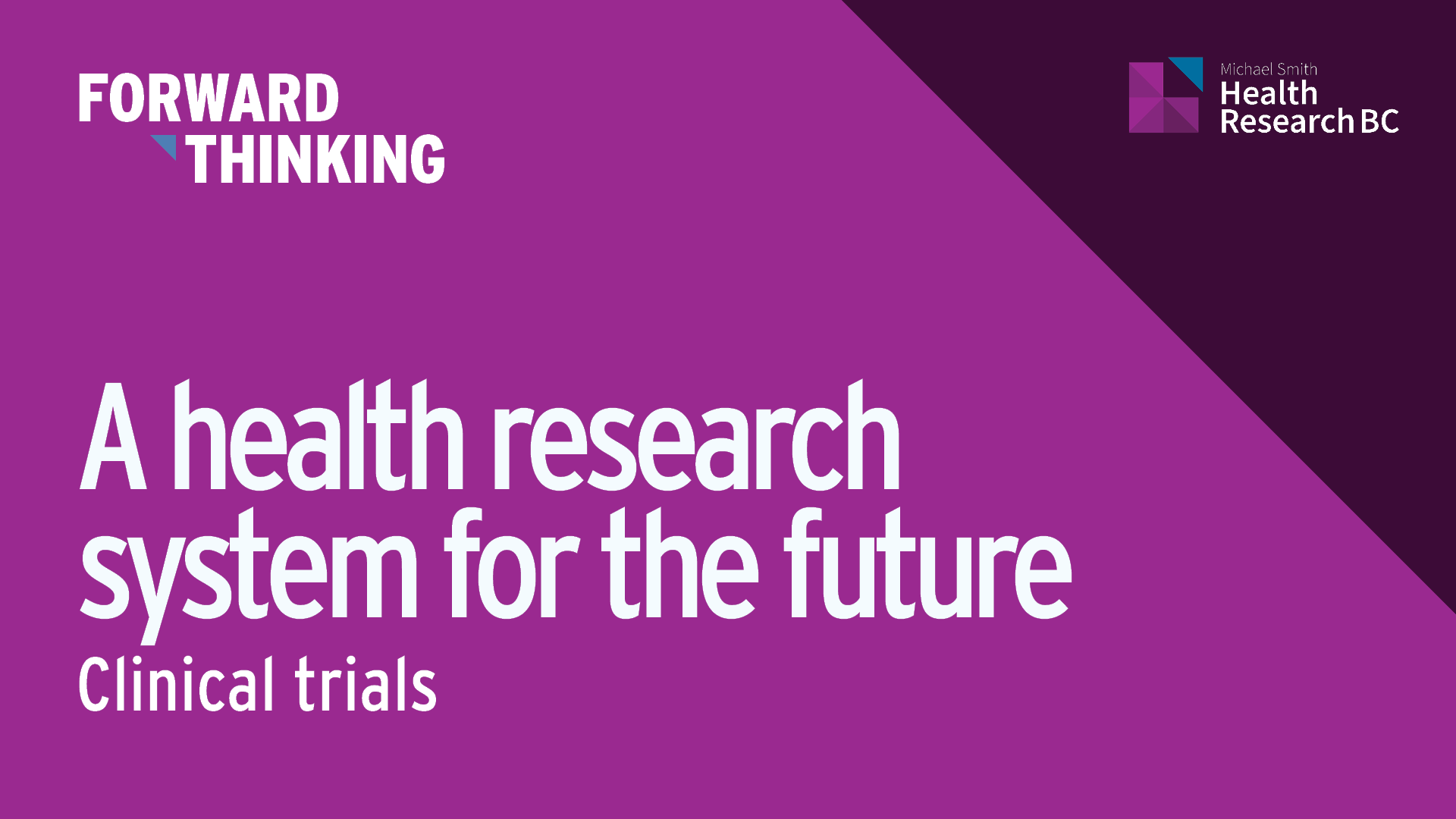A health research funder’s role in public and patient engagement
15 January 2019

Public and patient engagement (PPE) in health care, policy and research is increasingly seen as a key strategy to drive health system transformation, and ultimately, better health outcomes.
MSFHR is relatively new to this area but is keen to take a leadership role in implementing PPE in a funding organization. Here, the MSFHR team leading the Foundation’s public and patient engagement strategy, Lori Last, Zena Sharman and Maija Tiesmaki reflect on the valuable lessons learnt while developing the strategy, and where we go from here.
Forward Thinking is MSFHR’s blog, focusing on what it takes to be a responsive and responsible research funder.
A health research funder’s role in public and patient engagement: Building solid and sustainable foundations
Engaging patients and the public in health research is increasingly seen as a way to ensure research is meaningful for those it affects, and can be more readily applied to improve care. In support of this, jurisdictions around the world are embarking on patient and public engagement (PPE) initiatives to help transform health research practice, and health research funding agencies are investing heavily in PPE in research. But, there is still much to learn.
The United Kingdom is a leader in this area: the National Institute for Health Research has developed PPE standards and actively supports its funded researchers to involve patients and the public in their work. Similarly the Wellcome Trust, a private health research funder, recently released a public and patient engagement strategy. Here at home, the Canadian Institutes of Health Research has invested millions of dollars in its multi-year Strategy for Patient-Oriented Research that seeks to involve patients in research to improve the translation of new diagnostic tools and therapies into care. The BC SUPPORT Unit is one of the products of this investment, an organization dedicated to advancing the practice and science of patient-oriented research in our province.
At MSFHR, we want to support our funded researchers to involve the public and patients in their research and knowledge translation activities, while also bringing public and patient perspectives into our own work as a health research funding agency. This is a new area for the Foundation, and we want to make sure we enter this space meaningfully and thoughtfully. While the evidence base for PPE continues to grow, there is less literature addressing how health research funding agencies can best support PPE or evaluate the impact of their PPE activities, and just a few funders to serve as role models. Like other funders working in this domain, we are breaking new ground and learning as we go.
In this blog post, we share an overview of our journey so far, the challenges we’ve encountered, lessons learned, and where we plan to go from here. It is one way we are staying true to our commitment to accountability in our PPE work.
Developing a public and patient engagement strategy
We began the work to create a PPE strategy in 2016, engaging in a process that included environmental scanning, a consultation workshop and key informant interviews with PPE experts, funding agencies and patient advocates. By early 2017, we had developed a vision, guiding principles, and four strategic opportunities that focused on supporting research that integrates PPE, funding research on PPE itself, incorporating public and patient perspectives into our grant review process and ensuring PPE informs MSFHR’s strategic decision-making.
With this under our belts, we brainstormed tactics, wrote an implementation plan and thought we were ready to go. In reality, turning this high-level strategy into action has been challenging. Like other health research funding agencies working in this sphere, we want to demonstrate a tangible and sustained commitment to PPE. However, our experience has shown us that building a solid and sustainable foundation for PPE at MSFHR, and in the research we fund, is going to take time.
Challenges and learnings
When we started the process of developing our PPE strategy in 2016 we had ambitious plans to complete the strategy and implement at least some of the tactics in our plan within two years. As that timeline draws to a close, we’ve been reflecting on the challenges we’ve faced so far and the advice we’d give to other health research funding agencies embarking on a similar journey.
- Have a clear reason why you are engaging
We thought our rationale for entering into PPE was clear and well-articulated. It was the right thing to do, it would help us be more transparent and accountable and it would lead to higher quality and more relevant, actionable research that benefited patients. As we got deeper into implementation, we realized our vision of “integrating public and patient perspectives into our work…to enable relevant, accessible and useable research that improves health outcomes and the health system in BC” was missing a clear “why”. This lack of clarity was limiting our capacity to move forward. When we turned to the literature to learn from others, we discovered that there aren’t many funders doing this type of work and the ones who are face similar struggles. Our counterparts at the Wellcome Trust, a funding agency that is involved in numerous PPE activities, gave us wise advice and a valuable reminder: be clear about the outcomes you want to see. We identified a shared desire to bring together other health research funders to discuss how we are approaching PPE, and why it matters to us and plan to move forward with this work in early 2019. - Clearly define your ‘publics’ and ‘patients’
Funders focused on a particular health condition or population group, like the MS Society of Canada or the Rick Hansen Foundation, have clearer boundaries for defining their ‘patients’ and ‘publics’. But as BC’s health research funder, we support everything from basic biomedical investigations to community-based initiatives involving a wide range of health concerns and populations. How can we identify representative patients and members of the public who can participate in a meaningful way? Or, more challengingly, does the definition of these groups change depending on the context?We considered the role of our Board of Directors – could they be considered proxies for the public? Or could the research users [1] on our KT-focused awards (Reach, Convening & Collaborating (C2), and Implementation Science Teams) fill this role? It depends, as there isn’t consistent terminology around roles in PPE in health research [2], nor clear parameters around who counts as a “stakeholder” or “community member” [3]. This is an issue we are still grappling with, and we continue to explore various options while seeking alignment with the terminology most commonly used in BC and Canada.What we have learned at this early stage in our PPE journey is that we need to keep our activities focused and bring the public and patients into our work for targeted activities where both the participants and the Foundation will benefit from the engagement. We will take guidance from recent literature calling for solid theoretical and practical frameworks to guide the engagement process [2] and cautioning against PPE initiatives that are insignificant, tokenistic, and overly managerial.[4] We will reflect on our early activities and continue to move forward and evolve our approach to PPE over time. - Clearly define what counts as PPE, and how it relates to what you are already doing
From an operational perspective, we had to inventory where we were already contributing to PPE and take those activities into account as we began thinking about new activities where we might intentionally embed PPE directly into our work.To begin with, we are a significant funder and an active collaborator in the BC SUPPORT Unit. We have directed our funding of the Unit to methods clusters, designed to advance the science of patient-oriented research and we are a funder and a partner on the Pathway to Patient-Oriented Research (P2P) awards, which help patient-oriented research teams to pilot and test the feasibility of their projects.We also regularly partner with patient-oriented non-profits like the BC Schizophrenia Society Foundation and the Pacific Alzheimer Research Foundation, to co-fund MSFHR awards and help those organizations fund research that is important to the people they serve.Beyond this we have looked at involving members of the public or patient representatives in our peer review process, or inviting them to help us set research priorities. As a first step, we will explore the possibility of convening a roundtable of public and patient representatives to provide input on how MSFHR could make our funding review processes and suite of programs more public and patient friendly.We will continue to work with others in our environment, especially organizations like the BC SUPPORT Unit that are actively engaged in facilitating patient-oriented research to ensure our activities enhance their efforts and reflect our role as a publicly-funded health research funding agency. - Go slow and steady, with courage and a sense of exploration
One of our biggest learnings has been that PPE is not a task, but an approach. We have learned that to support meaningful PPE in an evolving field we will need to proceed slowly and deliberately, maintaining a sense of exploration and experimentation and being open to trying, and failing, before we get it right.We need to keep reminding ourselves that not all of our activities lend themselves to meaningful public or patient engagement and that dedicated human and financial resources are needed to do this work well. We need to focus our PPE efforts on activities that hold potential to add value not only for our organization but for the individuals who choose to engage with us.
More broadly, we have adopted an incremental approach, learning from each activity before expanding further. We have updated our strategy to reflect what we’ve learned and we will carefully evaluate the roll-out of our PPE activities to ensure they are working as intended. And of course, we will continue to learn and improve as we go.
Reflecting on our PPE journey to date has been a valuable lesson. Our internal and external conversations have helped us clarify how to move forward in an authentic and appropriate way, and have shown us that we are not alone in facing these challenges as we work to build solid and sustainable foundations for PPE at MSFHR.
We would love to hear from other funding agencies involved in PPE, so we can share experiences and learn from each other as we navigate this new landscape together. Please reach out to Lori Last, director, marketing and communications, Zena Sharman, director, strategy; or Maija Tiesmaki, senior specialist, strategic initiatives, with any comments or questions about our PPE strategy and where we plan to go next.
Footnotes and references
- For the purposes of its funding competitions, MSFHR uses an adapted version of CIHR’s Guide to Knowledge Translation Planning to help define research users. Research users can include other researchers, policy makers, health care practitioners, decision makers, health care administrators, educators, patient user group, or health charity, and the public.
- Manafo, E. et al. (2018). Patient engagement in Canada: A scoping review of the ‘how’ and ‘what’ of patient engagement in health research. Health Research Policy and Systems, 16:5. doi: 10.1186/s12961-018-0282-4.
- Lavery, J.V. (2018). Building an evidence base for stakeholder engagement: the private sector provides lessons and models. Science, 361(6042): 554-556.
- Madden M and Speed E (2017) Beware Zombies and Unicorns: Toward Critical Patient and Public Involvement in Health Research in a Neoliberal Context. Front. Sociol. 2:7. doi: 10.3389/fsoc.2017.00007





